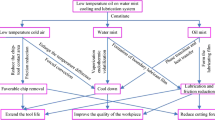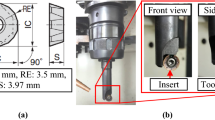Abstract
Wet cutting is the most common cooling method used during the cutting of titanium alloys. However, this method is associated with high costs, pollution, and hazards to operators. Minimal quantity lubrication (MQL) is an effective environmentally friendly cooling method, but is not suitable for difficult-to-machine materials because of its low heat transfer capacity. Using cryogenic air mixed with MQL (CAMQL) for cooling has better heat transfer, but high equipment costs and noise pollution limit its industrial application. This paper proposes the use of oils on water (OoW) as a cooling method for the turning of Ti-6Al-4V alloy and aims at exploring the effect of OoW cooling. Both external oils on water (EOoW) and internal oils on water (IOoW) methods are considered. The effects of EOoW spraying location and the amount of water required for IOoW are compared with respect to chip morphology, cutting temperatures, cutting forces, surface roughness, and tool wear. The use of CAMQL at different air temperatures is compared with wet and dry cutting. The results show that the chips created by OoW and CAMQL are continuous spirals. Compared with CAMQL, use of IOoW cooling with an appropriate amount of water or EOoW cooling from a proper location yields lower surface roughness and slower flank wear rate, and bare areas on the cutting tool substrate were absent because of better lubrication. The properties of the lubricants have an influence on IOoW and CAMQL, but not on EOoW. A suitable cutting tool coating should be selected to ensure the best cutting performance under these cooling methods.
Similar content being viewed by others
References
Arrazola PJ, Garay A, Iriarte LM, Armendia M, Marya S, Le Maître F (2009) Machinability of titanium alloys (Ti6Al4V and Ti555.3). J Mater Process Tech 209(5):2223–2230
Liu ZQ, An QL, Xu JY, Chen M, Han S (2013) Wear performance of (nc-AlTiN)/(a-Si3N4) coating and (nc-AlCrN)/(a-Si3N4) coating in high-speed machining of titanium alloys under dry and minimum quantity lubrication (MQL) conditions. Wear 305:249–259
Rahman M, Wang ZG, Wong YS (2006) A review on high-speed machining of titanium alloys. Int J C-Mech Sys Mach Elem Manuf 49(1):11–20
Hassan A, Yao ZQ (2004) Minimum lubrication milling of titanium alloys. Mater Sci Forum 471–472:87–91
Sutherland JW, Kulur VN, King NC (2000) An experimental investigation of air quality in wet and dry turning. CIRP Ann Manuf Technol 49(1):61–64
Klocke F, Eisenblätter G (1997) Dry cutting. CIRP Annals - Manuf Technol 46(2):519–526
Sreejith PS, Ngoi BKA (2000) Dry machining: machining of the future. J Mater Proc Tech 101(1):287–291
Kaynak Y, Karaca HE, Jawahir IS (2014) Surface integrity characteristics of NiTi shape memory alloys resulting from dry and cryogenic machining. Procedia CIRP 13:393–398
Manimaran G, Kumar MP, Venkatasamy R (2013) Influence of cryogenic cooling on surface grinding of stainless steel 316. Cryogenics 59:76–83
Cordes S, Hübner F, Schaarschmidt T (2014) Next generation high performance cutting by use of carbon dioxide as cryogenics. Procedia CIRP 14:401–405
Dhananchezian M, Pradeep KM (2011) Cryogenic turning of the Ti-6Al-4V alloy with modified cutting tool inserts. Cryogenics 51(1):34–40
Bermingham MJ, Kirsch J, Sun S, Palanisamy S, Dargusch MS (2011) New observations on tool life, cutting forces and chip morphology in cryogenic machining Ti-6Al-4V. Int J Mach Tools Manuf 51(6):500–511
Klocke F, Krämer A, Sangermann H, Lung D (2012) Thermo-mechanical tool load during high performance cutting of hard-to-cut materials. Procedia CIRP 1:295–300
Evans C, Bryan JB (1991) Cryogenic diamond turning of stainless steel. CIRP Annals - Manuf Technol 40(1):571–575
Dhar NR, Paul S, Chattopadhyay AB (2002) Role of cryogenic cooling on cutting temperature in turning steel. J Manuf Sci Eng 124:146–154
Godlevsk VA (1998) Water steam lubrication during machining. Tribol 162(6):890–901 (in Italian)
Han RD, Hu GY (2003) Experimental investigation of cutting with water vapor as cooling lubricant. Mod Manuf Eng 2:12–13 (in Chinese)
Liu JY, Han RD, Zhang L, Guo HB (2007) Study on lubricating characteristic and tool wear with water vapor as coolant and lubricant in green cutting. Wear 262(3):442–452
Liu JY, Han RD, Sun YF (2005) Research on experiments and action mechanism with water vapor as coolant and lubricant in green cutting. Int J Mach Tools Manuf 45(6):687–694
Chinchanikar S, Choudhury SK (2014) Hard turning using HiPIMS-coated carbide tools: Wear behavior under dry and minimum quantity lubrication (MQL). Measurement 55:536–548
Sohrabpoor H, Khanghah S, Teimouri R (2014) Investigation of lubricant condition and machining parameters while turning of AISI 4340. Int J Adv Manuf Technol. doi:10.1007/s00170-014-6395-1
Hadad M, Sadeghi B (2013) Minimum quantity lubrication-MQL turning of AISI 4140 steel alloy. J Clean Prod 54:332–343
Liu ZQ, Chen M, An QL (2015) Investigation of friction in end-milling of Ti-6Al-4V under different green cutting conditions. Int J Adv Manuf Technol. doi:10.1007/s00170-014-6730-6
Su Y, He N, Li L, Li XL (2006) An experimental investigation of effects of cooling/lubrication conditions on tool wear in high-speed end milling of Ti-6Al-4V. Wear 261(7):760–766
Bhowmick S, Alpas AT (2011) The role of diamond-like carbon coated drills on minimum quantity lubrication drilling of magnesium alloys. Surf Coat Technol 205(23):5302–5311
Biermann D, Iovkov I, Blum H, Rademacher A, Taebi K, Suttmeier FT, Klein N (2012) Thermal aspects in deep hole drilling of aluminium cast alloy using twist drills and MQL. Procedia CIRP 3:245–250
Rahim EA, Sasahara HA (2011) A study of the effect of palm oil as MQL lubricant on high speed drilling of titanium alloys. Tribol Int 44(3):309–317
Oliveira DD, Guermandi LG, Bianchi EC, Diniz AE, de Aguiar PR, Canarim RC (2012) Improving minimum quantity lubrication in CBN grinding using compressed air wheel cleaning. J Mater Proc Technol 212(12):2559–2568
Morgan MN, Barczak L, Batako A (2012) Temperatures in fine grinding with minimum quantity lubrication (MQL). Int J Adv Manuf Technol 60(9–12):951–958
Hadad M, Sadeghi B (2012) Thermal analysis of minimum quantity lubrication-MQL grinding process. Int J Mach Tools Manuf 63:1–15
Tai BL, Stephenson DA, Furness RJ, Shih AJ (2014) Minimum quantity lubrication (MQL) in automotive powertrain machining. Procedia CIRP 14:523–528
Itoigawa F, Childs THC, Nakamura T, Belluco W (2006) Effects and mechanisms in minimal quantity lubrication machining of an aluminum alloy. Wear 260(3):339–344
Su Y, He N, Li L, Iqbal A, Xiao MH, Xu S, Qiu BG (2007) Refrigerated cooling air cutting of difficult-to-cut materials. Int J Mach Tools Manuf 47(6):927–933
Yuan SM, Yan LT, Liu WD, Liu Q (2011) Effects of cooling air temperature on cryogenic machining of Ti-6Al-4V alloy. J Mater Proc Tech 211(3):356–362
Wang CY, Xie YX, Zhen LJ, Qin Z, Tang DW, Song YX (2014) Research on the chip formation mechanism during the high-speed milling of hardened steel. Int J Mach Tools Manuf 79:31–48
Venugopal KA, Paul S, Chattopadhyay AB (2007) Growth of tool wear in turning of Ti-6Al-4V alloy under cryogenic cooling. Wear 262(9):1071–1078
An QL, Fu YC, Xu JH (2011) Experimental study on turning of TC9 titanium alloy with cold water mist jet cooling. Int J Mach Tools Manuf 51:549–555
Author information
Authors and Affiliations
Corresponding author
Rights and permissions
About this article
Cite this article
Lin, H., Wang, C., Yuan, Y. et al. Tool wear in Ti-6Al-4V alloy turning under oils on water cooling comparing with cryogenic air mixed with minimal quantity lubrication. Int J Adv Manuf Technol 81, 87–101 (2015). https://doi.org/10.1007/s00170-015-7062-x
Received:
Accepted:
Published:
Issue Date:
DOI: https://doi.org/10.1007/s00170-015-7062-x




